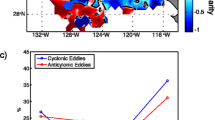Abstract
The evolution of a front that forms inshore of the main Chesapeake Bay plume, near Cape Henry, Virginia, United States, was observed during a period of downwelling-favorable winds in May 1999. A novel aspect of this study was the use of an underway, horizontally-oriented acoustic Doppler current profiler (ADCP) to map the front and to study its evolving shape. Measurements made during flood tide show the front forming about 2 km from shore and then advancing shoreward (at about 20 cm s−1) over dense, inshore water. Measurements made while anchored 1 km from shore show the surface salinity increasing during ebb tide, then abruptly decreasing during flood tide as the front moves inshore. To account for this cycle of events, a conceptual model is proposed in which dense water upwells to the surface during ebb tide near Cape Henry, helping to set the stage for frontal formation on the flood. The cyclic recurrence of this Cape Henry front so close to the mouth of the bay may provide a mechanism for recirculating estuarine material that would otherwise be transported southward in the coastal buoyancy current.
Similar content being viewed by others
Literature Cited
Boicourt, W. C. 1981. Circulation in the Chesapeake Bay entrance region: Estuary-shelf interaction, p. 61–78.In J. W. Campbell and J. P. Thomas (eds.), Chesapeake Bay Plume Study: Superflux 1980. NASA Conference Publication 2188. NASA, Scientific and Technical Information Branch, Washington, D.C.
Cooper, A. L., R. P. Mied, andG. J. Lindemann. 2001. The evolution of freely propagating, two-dimensional surface gravity current fronts.Journal of Geophysical Research-Oceans 106: 16887–16901.
Gallacher, P. C., M. Schaferkotter, andP. Martin. 2000. Topographic and wind influences on the Chesapeake Bay outflow plume and the associated fronts, p. 443–451.In M. L. Spaulding and H. L. Butler (eds.), Proceedings of the Sixth International Conference on Estuarine and Coastal Modeling Meeting, ASCE, New Orleans, Louisiana.
Johnson, D. R. andA. D. Weidemann. 1998. A tidal plume front and internal solitons.Continental Shelf Research 18:923–928.
Klinger, B. A. 1994. Inviscid current separation from rounded capes.Journal of Physical Oceanography 24:1805–1811.
Largier, J. L. 1992. Tidal intrusion fronts.Estuaries 15:16–39.
Luketina, D. A. andJ. Imberger. 1987. Characteristics of a surface buoyant jet.Journal of Geophysical Research 92:5435–5447.
Marmorino, G. O., T. F. Donato, M. A. Sletten, andC. L. Trump. 2000. Observations of an inshore front associated with the Chesapeake Bay outflow plume.Continental Shelf Research 20:665–684.
Marmorino, G. O. andC. L. Trump. 2000a. Shore-based acoustic Doppler measurements of near-surface currents across a small embayment.Journal of Coastal Research 16:864–869.
Marmorino, G. O. andC. L. Trump. 2000b. Gravity current structure of the Chesapeake Bay outflow plume.Journal of Geophysical Research 105:28,847–28,861.
Marmorino, G. O., C. L. Trump, andZ. R. Hallock. 1999. Near-surface current measurements using a ship-deployed “horizontal” ADCP.Journal of Atmospheric and Oceanic Technology 16:1456–1463.
Mied, R. P., A. L. Cooper, G. J. Lindemann, andM. A. Sletten. 2002. Wave propagation along freely propagating surface gravity current fronts.Dynamics of Atmospheres and Oceans 36:59–81.
O’Donnell, J., G. O. Marmorino, andC. L. Trump. 1998. Convergence and downwelling at a river plume front.Journal of Physical Oceanography 28:1481–1495.
Sanders, T. M. andR. W. Garvine. 1996. Frontal observations of the Delaware Coastal Current source region.Continental Shelf Research 16:1009–1021.
Seim, H. E. andM. C. Gregg. 1997. The importance of aspiration and channel curvature in producing strong vertical mixing over a sill.Journal of Geophysical Research 102:3451–3472.
Sletten, M. A., G. O. Marmorino, T. F. Donato, D. J. McLaughlin, andE. Twarog. 1999. An airborne, real-aperture radar study of the Chesapeake Bay Outflow Plume.Journal of Geophysical Research 104:1211–1222.
Trump, C. L., N. Allan, andG. O. Marmorino. 2000. Sidelooking ADCP and Doppler radar measurements across a coastal front.IEEE Journal of Ocean Engineering 25:423–429.
Valle-Levinson, A., C. Li, T. C. Royer, andL. P. Atkinson. 1998. Flow patterns at the Chesapeake Bay entrance.Continental Shelf Research 18:1157–1178.
Wiseman, W. J. andR. W. Garvine. 1995. Plumes and coastal currents near large river mouths.Estuaries 18:509–517.
Source of Unpublished Materials
Holderied, K. and A. Valle-Levinson. Unpublished manuscript. Center for Coastal Physical Oceanography, Old Dominion University, Norfolk, Virginia 23529.
Author information
Authors and Affiliations
Corresponding author
Rights and permissions
About this article
Cite this article
Marmorino, G.O., Trump, C.L. Evolution of the Cape Henry front. Estuaries 27, 389–396 (2004). https://doi.org/10.1007/BF02803531
Received:
Accepted:
Issue Date:
DOI: https://doi.org/10.1007/BF02803531




